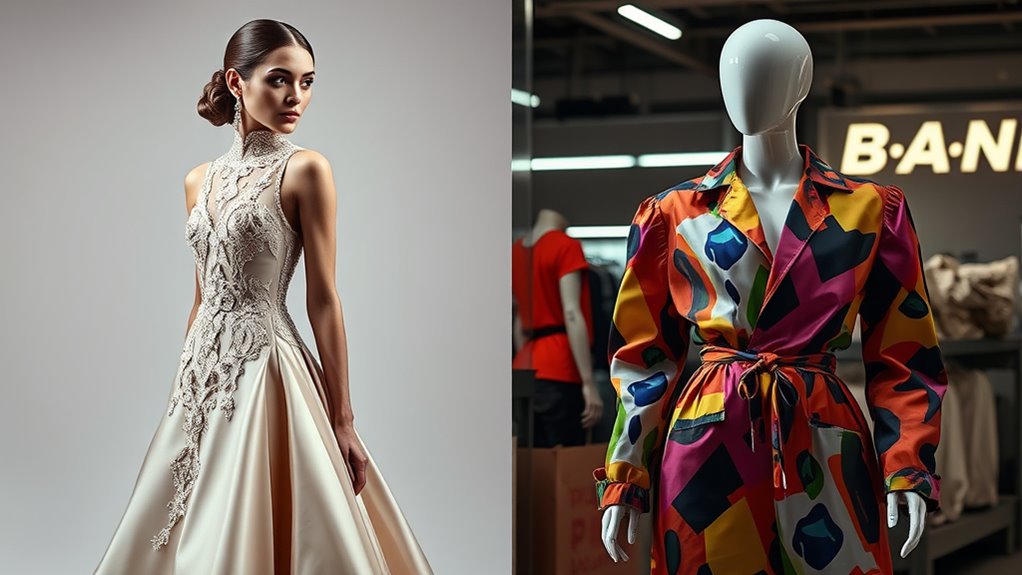High fashion sets trends through innovative designs and craftsmanship, often released slowly and costing more, making them exclusive. Fast fashion quickly copies trends, producing affordable items in mass quantities with rapid turnaround times, but often sacrificing quality and ethics. While high fashion focuses on creativity and sustainability, fast fashion prioritizes speed and affordability. To understand how these differences impact your choices and the environment, keep exploring what sets these styles apart.
Key Takeaways
- High fashion emphasizes innovation, craftsmanship, and exclusivity, while fast fashion prioritizes rapid trend replication and affordability.
- Trends in high fashion develop slowly through designer collections, whereas fast fashion quickly copies and mass-produces trending styles.
- High fashion focuses on sustainability and quality, contrasting with fast fashion’s resource-intensive, wasteful manufacturing processes.
- High fashion items are costly, limited, and often serve as investment pieces, whereas fast fashion offers low-cost, disposable trend items.
- Trend dissemination in high fashion is slow and exclusive, while fast fashion relies on social media and influencer culture for rapid spread.
Origins and Development of Trends
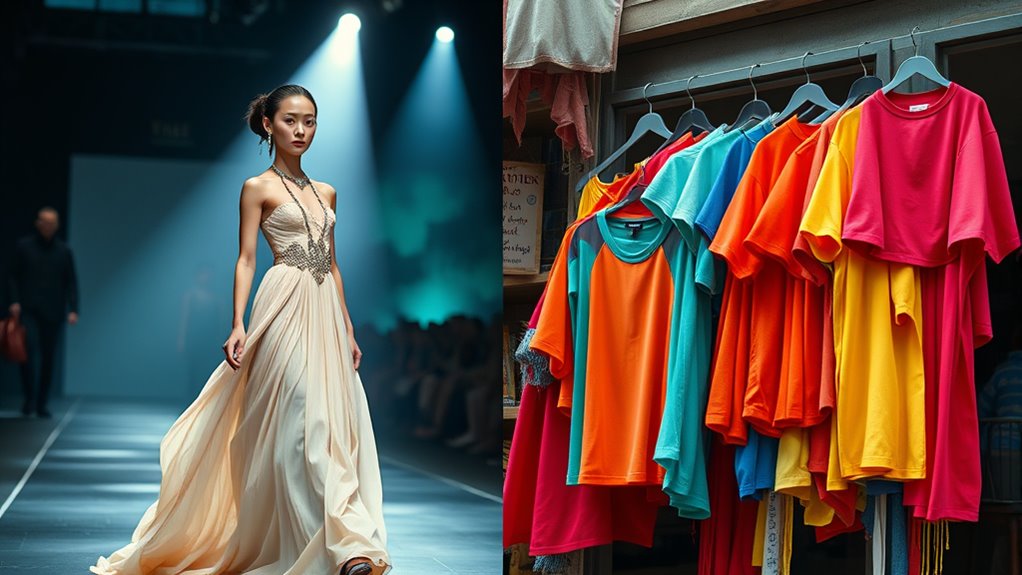
Have you ever wondered where fashion trends originate and how they evolve over time? Trends often start with influential designers, celebrities, or runway shows, setting a style that catches people’s attention. Over time, these styles spread through magazines, social media, and word of mouth, gaining popularity quickly or slowly depending on their appeal. High fashion influences the mainstream by introducing innovative, often daring ideas that trickle down into everyday wear. Conversely, fast fashion brands rapidly adapt these trends, making them accessible and affordable for everyone. The development of trends is a dynamic process, shaped by cultural shifts, technological advances, and consumer desire for novelty. Additionally, for sale 100, the affordability and quick turnover of fast fashion contribute significantly to how trends are adopted and discarded. The rapid dissemination of trends is also facilitated by the fashion industry’s embrace of digital platforms and influencer culture, which accelerates the cycle from runway to retail. This constant evolution is further driven by the rapid pace of change in consumer preferences and technological innovations that enable faster production and distribution. The influence of Glycolic Acid benefits in skincare is an example of how trends in beauty also follow rapid cycles of innovation and adoption. Understanding this evolution helps you see how what you wear today might have started on the runway or in pop culture.
Production Processes and Speed
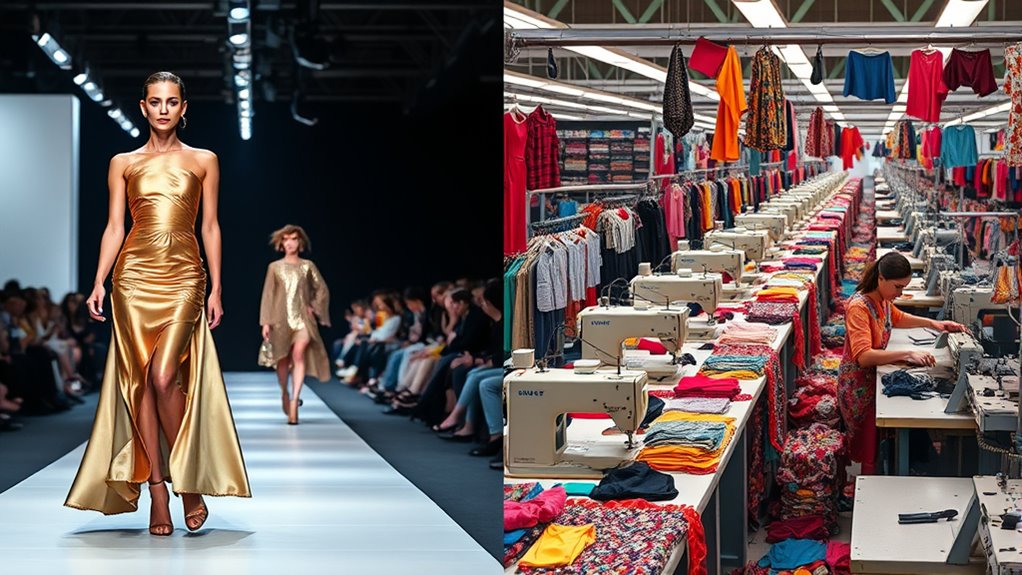
The production processes behind high fashion and fast fashion differ markedly in both complexity and speed. High fashion involves meticulous craftsmanship, limited quantities, and longer lead times, often taking months to produce unique, high-quality pieces. You’ll notice that designers carefully select fabrics, hand-assemble garments, and focus on detailed finishing. Conversely, fast fashion prioritizes rapid turnaround and mass production. You can expect garments to go from design to store shelves within weeks, thanks to streamlined manufacturing, often in offshore factories. Automation and standardization play a significant role, allowing brands to respond quickly to emerging trends. This speed enables fast fashion brands to keep their collections constantly refreshed, while high fashion emphasizes the mind-body connection and craftsmanship over quick turnover. Additionally, the emphasis on natural elements in high fashion can influence the choice of materials and design philosophies, setting it apart from the more industrialized process of fast fashion. Understanding the relationships involved in supply chains underscores the importance of ethical considerations in fashion production. Moreover, high fashion often incorporates a focus on sustainable practices, which contrasts with the faster, often more environmentally impactful nature of fast fashion. Furthermore, the complexity of high fashion production typically involves skilled artisans and specialized techniques not found in fast fashion, highlighting the contrast in production complexity.
Design Philosophy and Creativity

While fast fashion often relies on quickly replicating trends to meet consumer demand, high fashion is driven by a deep-rooted commitment to innovation and artistic expression. High fashion designers push boundaries, creating original, handcrafted pieces that showcase their unique vision. They prioritize craftsmanship, intricate detailing, and artistic exploration. In contrast, fast fashion emphasizes copying popular styles rapidly and affordably, often sacrificing originality for mass appeal. This difference in design philosophy highlights the creative core of each approach. Additionally, the emphasis on Vetted – ID Times resources and industry standards underscores the importance of originality and craftsmanship in high fashion. Moreover, high fashion often employs wider tires and other specialized features that demonstrate their focus on innovation and distinctiveness, setting them apart from fast fashion’s mass-produced offerings. Furthermore, high fashion maintains a focus on trademark protection, helping designers safeguard their unique creations and brand identity in a competitive market. Recognizing the importance of creative integrity ensures that high fashion continues to lead in originality and artistic expression.
Pricing and Accessibility
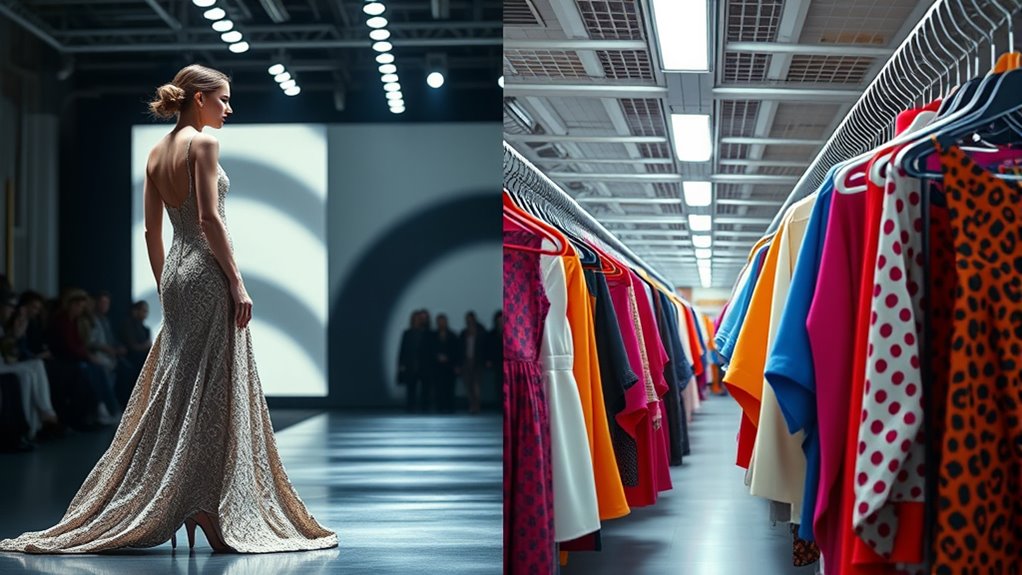
You’ll notice that high fashion pieces often come with steep price tags, making them less accessible to most people. Fast fashion, on the other hand, offers trendy items at a fraction of the cost, reaching a wider audience. While investment value varies, fast fashion’s affordability makes it easier to keep up with changing styles without breaking the bank. Additionally, the pricing and accessibility of these styles play a significant role in consumer choices and fashion trends. The affordability of fast fashion also influences consumer behavior, encouraging more frequent purchases and rapid trend adoption. Moreover, the rapid production cycles in fast fashion can sometimes lead to cybersecurity vulnerabilities, as companies rush to meet demand and may overlook security protocols. Incorporating delicate skincare products like eye patches into routine shopping habits reflects the broader trend of prioritizing self-care alongside fashion choices. Understanding the manufacturing processes behind fast fashion can help consumers make more informed decisions about sustainability and ethics.
Price Points Comparison
High fashion brands often set premium price points that make their pieces feel exclusive and luxurious, putting them out of reach for most consumers. These prices reflect craftsmanship, designer branding, and limited production runs, creating a sense of rarity. In contrast, fast fashion offers much lower prices, making trendy items accessible to a wider audience. You can buy multiple pieces for the cost of a single high-end item, allowing for frequent updates to your wardrobe. While fast fashion prioritizes affordability, high fashion emphasizes quality and exclusivity, which justifies the higher price. Your budget and fashion goals largely determine your choices. If you seek investment pieces and status symbols, high fashion’s price points align with that. If you prefer variety and affordability, fast fashion makes it easier to stay on trend without breaking the bank. Additionally, understanding the consumer behavior that influence consumer behavior can help you make more informed fashion choices. Recognizing your own consumer preferences can guide you toward brands that match your values and lifestyle. Moreover, awareness of market segmentation can assist in selecting brands that cater to your specific fashion needs and spending capacity, especially considering the different price points available across the fashion industry.
Availability and Reach
High fashion brands often have limited availability, with their products sold through exclusive boutiques, high-end department stores, or by invitation only. This exclusivity makes their items harder to access and more desirable, often reserved for a select clientele. In contrast, fast fashion brands prioritize broad accessibility, offering their products in numerous stores, online platforms, and even international markets. Their lower price points mean you can quickly and affordably update your wardrobe without much effort. With fast fashion, reach is extensive—you can find trendy pieces almost anywhere, anytime. High fashion’s limited reach creates a sense of rarity and status, while fast fashion’s widespread availability ensures that trendiness is accessible to everyone, regardless of location or budget. Additionally, air-purifying plants like the Snake Plant or Pothos can enhance the environment of any accessible space, reflecting a trend toward healthier, more sustainable living environments. Moreover, the rise of smart appliances in homes demonstrates how technology is making fashion and lifestyle choices more integrated and accessible for consumers. This widespread availability is supported by the growth of security systems that make home monitoring more accessible and user-friendly for all types of households. As technology advances, home automation devices continue to expand their reach, further integrating style and functionality into daily living.
Investment Value
When it comes to investment value, pricing and accessibility play essential roles in determining whether a piece is worth the cost. High fashion items often come with higher price tags, reflecting craftsmanship, brand prestige, and exclusivity. While these pieces may seem expensive initially, their quality and timeless appeal can lead to better resale value over time. Fast fashion, on the other hand, offers more affordable prices and easy accessibility, making trendy pieces quick to acquire. However, their lower durability and rapid obsolescence mean they typically don’t hold value. If you’re considering investments, high fashion offers more long-term worth, but it requires a bigger upfront commitment. Fast fashion might suit short-term trends, but it’s less likely to appreciate or retain value over time.
Environmental and Ethical Impact
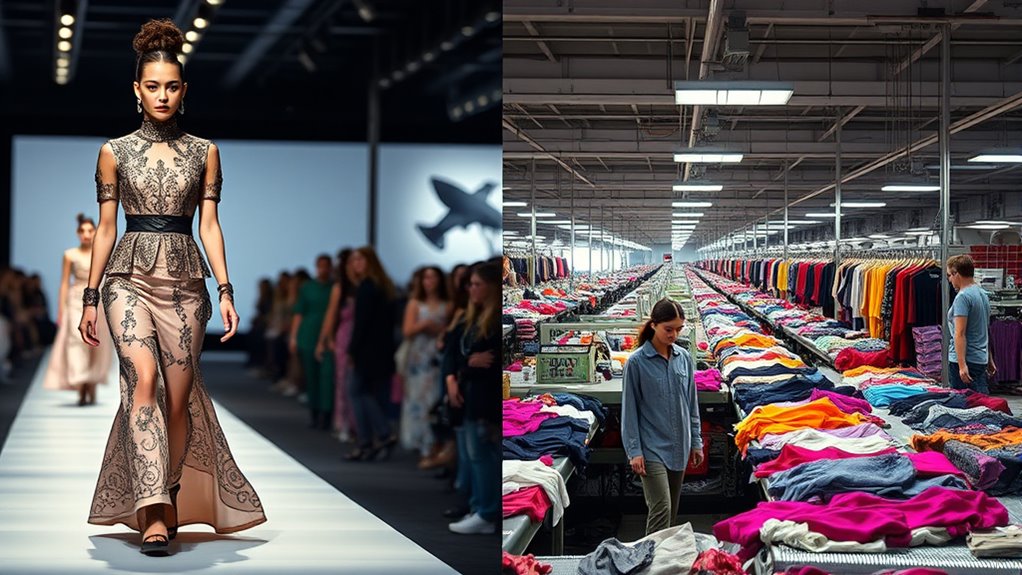
Fast fashion often uses more resources and generates more waste than high-end fashion, impacting the environment profoundly. You should also consider how labor conditions vary, with some fast fashion brands prioritizing low costs over worker rights. These differences highlight the ethical concerns tied to both production methods.
Resource Consumption Differences
While fast fashion is often praised for its affordability and quick turnaround, it comes at a significant environmental and ethical cost. You’ll find that fast fashion consumes vast amounts of water, energy, and raw materials to produce cheap garments rapidly. This high resource use leads to depletion of natural resources and increased pollution from manufacturing processes. In contrast, high fashion brands typically prioritize quality over quantity, using fewer resources per item and investing in sustainable sourcing. Fast fashion’s emphasis on mass production results in excessive waste, as unsold clothing often ends up in landfills. Meanwhile, high fashion tends to focus on longevity and craftsmanship, reducing overall resource consumption. By choosing high fashion, you contribute to a more sustainable cycle with less environmental impact.
Labor Conditions Variances
The environmental and ethical impacts of labor conditions vary considerably between high fashion and fast fashion. Fast fashion often relies on cheap labor, leading to unsafe workplaces, poor wages, and exploitation. High fashion, in contrast, tends to emphasize better working conditions, though issues still exist. As a consumer, you should be aware of these realities:
- Workers in fast fashion factories face long hours, low pay, and hazardous environments.
- High fashion brands usually invest more in ethical sourcing, but violations still occur.
- Your purchasing choices can support fair treatment or perpetuate exploitation, making your role vital in fostering change.
Waste Generation Impact
Waste generation from fashion production considerably impacts both the environment and ethical standards. Fast fashion, with its rapid turnover, creates massive amounts of textile waste that often ends up in landfills, releasing harmful chemicals and greenhouse gases. You may not realize that discarded clothing can take decades to decompose, polluting soil and water sources. High fashion, although producing less waste overall, still contributes through excess materials and unsold inventory. Ethically, fast fashion’s emphasis on cheap, disposable garments encourages overproduction and exploitation, while high fashion may focus on sustainable practices. By choosing to support brands that prioritize eco-friendly materials and ethical production, you can reduce waste and lessen the environmental and social toll of your fashion choices. Your decisions directly influence the industry’s approach to waste management.
Consumer Behavior and Trend Adoption

Consumer behavior plays a pivotal role in shaping fashion trends, especially as people increasingly seek quick access to new styles. Your desire for instant gratification drives fast fashion’s rapid turnover, making trends spread like wildfire. When you follow influencers or social media, you’re influenced to buy quickly, often without thinking long-term. This rush to keep up fuels mass production and disposable clothing.
- You feel excited to wear the latest styles, fueling a cycle of constant consumption.
- Your need for affordability pushes you toward fast fashion, prioritizing price over quality.
- You crave uniqueness, yet follow mainstream trends, creating a paradoxical desire for both individuality and conformity.
Your choices directly influence trends’ speed and longevity, shaping the dynamic between high and fast fashion.
Frequently Asked Questions
How Do Luxury Brands Influence Mainstream Fashion Trends?
You may notice that luxury brands set the tone for mainstream fashion trends. They often showcase innovative designs on runways, which are then picked up by fast fashion retailers. When you see popular streetwear inspired by high-end labels, it’s because luxury brands influence what’s trendy. Their exclusivity and creativity trickle down, shaping the styles you see in everyday wear, making high fashion a driving force behind mainstream fashion.
What Role Does Social Media Play in Fast Fashion Popularity?
Imagine social media as a wildfire spreading rapidly—you’re just a spark, yet your post can ignite a trend overnight. Social platforms like TikTok and Instagram drastically boost fast fashion’s popularity, with 70% of consumers influenced by influencers’ hauls. You often see quick-turnaround styles trend within days, making fast fashion feel like a race you’re always trying to keep up with. It’s this immediacy that fuels the cycle of constant newness.
How Do Cultural Differences Impact Fashion Trend Adoption Globally?
You notice that cultural differences greatly influence how fashion trends spread worldwide. In some regions, traditional styles stay strong, shaping local preferences, while in others, there’s a quick embrace of global trends. You’ll see that cultural values, climate, and social norms determine what’s fashionable and how fast trends are adopted. By understanding these differences, you can appreciate why certain styles resonate more in specific cultures, shaping the global fashion landscape.
Are There Sustainable Options Within High Fashion Collections?
Imagine you’re browsing a high fashion collection, and suddenly you notice sustainable materials like organic cotton or recycled fabrics woven into the designs. You realize many high fashion brands now prioritize sustainability, using eco-friendly options to reduce environmental impact. You can choose pieces that are stylish and responsible, making a statement while supporting ethical practices. So yes, sustainable options are increasingly integrated into high fashion collections, blending luxury with environmental consciousness.
How Do Seasonal Changes Affect Trend Cycles in Both Sectors?
Seasonal changes influence trend cycles profoundly in both sectors. You’ll notice that as seasons shift, fast fashion brands quickly adapt by releasing new collections to match the weather and holidays, keeping you engaged. High fashion, however, tends to focus on seasonal shows and runway presentations, setting longer-term trends. Your fashion choices reflect these cycles, with fast fashion offering rapid updates and high fashion emphasizing timeless, seasonal pieces.
Conclusion
As you navigate the world of fashion, imagine standing at a crossroads: one path leads to the timeless elegance of high fashion, where each piece is a crafted masterpiece, and the other to the whirlwind of fast fashion, flashing by like neon signs. Whether you choose to savor the artistry or embrace the fleeting trends, remember your choices ripple outward—shaping the planet and defining your style. Your decision is the brushstroke on the canvas of fashion’s future.
